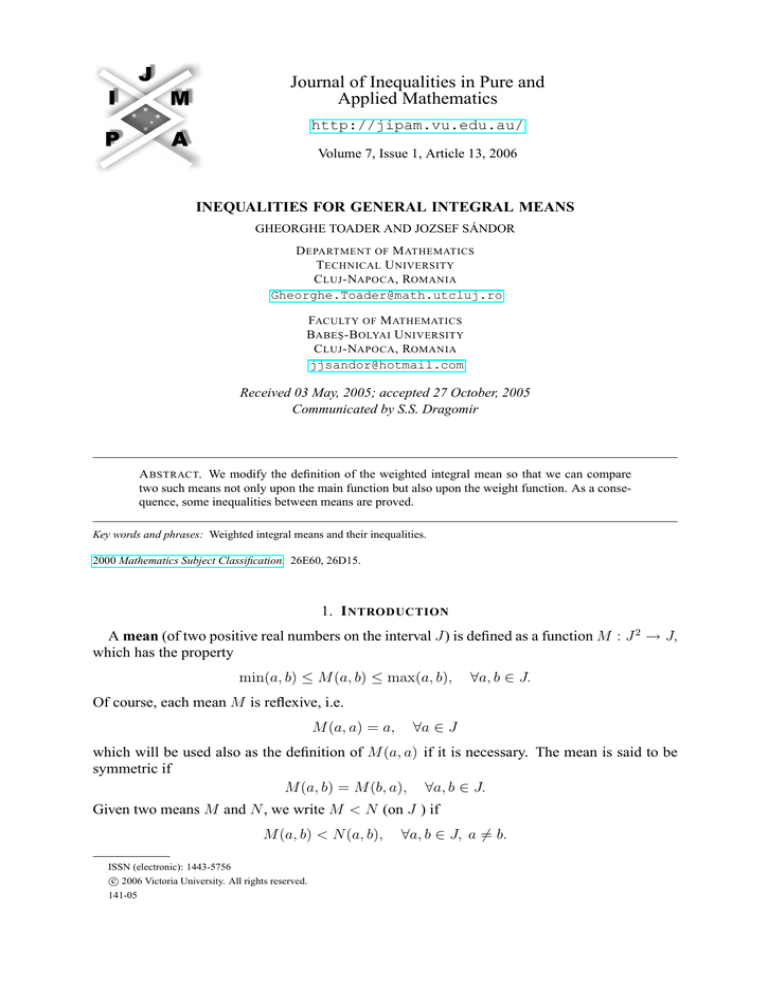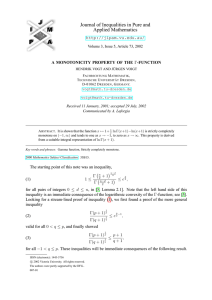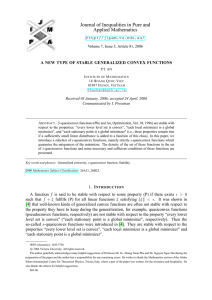
Journal of Inequalities in Pure and
Applied Mathematics
http://jipam.vu.edu.au/
Volume 7, Issue 1, Article 13, 2006
INEQUALITIES FOR GENERAL INTEGRAL MEANS
GHEORGHE TOADER AND JOZSEF SÁNDOR
D EPARTMENT OF M ATHEMATICS
T ECHNICAL U NIVERSITY
C LUJ -NAPOCA , ROMANIA
Gheorghe.Toader@math.utcluj.ro
FACULTY OF M ATHEMATICS
BABE Ş -B OLYAI U NIVERSITY
C LUJ -NAPOCA , ROMANIA
jjsandor@hotmail.com
Received 03 May, 2005; accepted 27 October, 2005
Communicated by S.S. Dragomir
A BSTRACT. We modify the definition of the weighted integral mean so that we can compare
two such means not only upon the main function but also upon the weight function. As a consequence, some inequalities between means are proved.
Key words and phrases: Weighted integral means and their inequalities.
2000 Mathematics Subject Classification. 26E60, 26D15.
1. I NTRODUCTION
A mean (of two positive real numbers on the interval J) is defined as a function M : J 2 → J,
which has the property
min(a, b) ≤ M (a, b) ≤ max(a, b),
∀a, b ∈ J.
Of course, each mean M is reflexive, i.e.
M (a, a) = a,
∀a ∈ J
which will be used also as the definition of M (a, a) if it is necessary. The mean is said to be
symmetric if
M (a, b) = M (b, a), ∀a, b ∈ J.
Given two means M and N , we write M < N (on J ) if
M (a, b) < N (a, b),
ISSN (electronic): 1443-5756
c 2006 Victoria University. All rights reserved.
141-05
∀a, b ∈ J, a 6= b.
2
G HEORGHE T OADER AND J OZSEF S ÁNDOR
Among the most known examples of means are the arithmetic mean A, the geometric mean
G, the harmonic mean H, and the logarithmic mean L, defined respectively by
A(a, b) =
H(a, b) =
a+b
,
2
2ab
,
a+b
√
G(a, b) =
L(a, b) =
a · b,
b−a
,
ln b − ln a
a, b > 0,
and satisfying the relation H < G < L < A.
We deal with the following weighted integral mean. Let f : J → R be a strictly monotone
function and p : J → R+ be a positive function. Then M (f, p) defined by
!
Rb
f
(x)
·
p(x)dx
a
M (f, p)(a, b) = f −1
, ∀a, b ∈ J
Rb
p(x)dx
a
gives a mean on J. This mean was considered in [3] for arbitrary weight function p and f =
en where en is defined by
( n
x , if n 6= 0
en (x) =
ln x, if n = 0.
More means of type M (f, p) are given in [2], but only for special cases of functions f.
A general example of mean which can be defined in this way is the extended mean considered
in [4]:
1
r bs − as s−r
Er,s (a, b) =
·
, s 6= 0, r 6= s.
s b r − ar
We have Er,s = M (es−r , er−1 ).
The following is proved in [6].
Lemma 1.1. If the function f : R+ → R+ is strictly monotone, the function g : R+ → R+ is
strictly increasing, and the composed function g ◦ f −1 is convex, then the inequality
M (f, p) < M (g, p)
holds for every positive function p.
The means A, G and L can be obtained as means M (en , 1) for n = 1, n = −2 and n = −1
respectively. So the relations between them follow from the above result. However, H =
M (e1 , e−3 ), thus the inequality H < G cannot be proved on this way.
A special case of integral mean was defined in [5]. Let p be a strictly increasing real function
having an increasing derivative p0 on J. Then Mp0 given by
Mp0 (a, b)
Z
=
a
b
x · p0 (x) · dx
,
p(b) − p(a)
a, b ∈ J
defines a mean. In fact we have Mp0 = M (e1 , p0 ).
In this paper we use the result of the above lemma to modify the definition of the mean
M (f, p). Moreover, we find that an analogous property also holds for the weight function. We
apply these properties for proving relations between some means.
J. Inequal. Pure and Appl. Math., 7(1) Art. 13, 2006
http://jipam.vu.edu.au/
I NEQUALITIES FOR G ENERAL I NTEGRAL M EANS
3
2. T HE N EW I NTEGRAL M EAN
We define another integral mean using two functions as above, but only one integral. Let f
and p be two strictly monotone functions on J. Then N (f, p) defined by
Z 1
−1
−1
N (f, p)(a, b) = f
(f ◦ p )[t · p(a) + (1 − t) · p(b)]dt
0
is a symmetric mean on J. Making the change of the variable
t=
[p(b) − s]
[p(b) − p(a)]
we obtain the simpler representation
N (f, p)(a, b) = f −1
Z
p(b)
(f ◦ p−1 )(s)ds
p(b) − p(a)
p(a)
!
.
Denoting f ◦ p−1 = g, the mean N (f, p) becomes
N 0 (g, p)(a, b) = p−1 ◦ g −1
Z
p(b)
p(a)
g(x)dx
p(b) − p(a)
!
.
Using it we can obtain again the extended mean Er,s as N 0 (es/r−1 , er ).
Also, if the function p has an increasing derivative, by the change of the variable
s = p(x)
the mean N (f, p) reduces at M (f, p0 ). For such a function p we have N (e1 , p) = Mp0 . Thus
Mp0 can also be generalized for non differentiable functions p at
Z 1
Mp (a, b) =
p−1 [t · p(a) + (1 − t) · p(b)]dt, ∀a, b ∈ J
0
or
Z
p(b)
Mp (a, b) =
p(a)
p−1 (s)ds
,
p(b) − p(a)
∀a, b ∈ J,
which is simpler for computations.
Example 2.1. For n 6= −1, 0, we get
n
bn+1 − an+1
·
, for a, b > 0,
n+1
b n − an
which is a special case of the extended mean. We obtain the arithmetic mean A for n = 1,
the logarithmic mean L for n = 0, the geometric mean G for n = −1/2, the inverse of the
logarithmic mean G2 /L for n = −1, and the harmonic mean H for n = −2.
Men (a, b) =
Example 2.2. Analogously we have
b · eb − a · ea
− 1 = E(a, b), a, b ≥ 0
eb − ea
which is an exponential mean introduced by the authors in [7]. We can also give a new exponential mean
a · eb − b · ea
M1/ exp (a, b) =
+ 1 = (2A − E)(a, b), a, b ≥ 0.
eb − ea
Mexp (a, b) =
J. Inequal. Pure and Appl. Math., 7(1) Art. 13, 2006
http://jipam.vu.edu.au/
4
G HEORGHE T OADER AND J OZSEF S ÁNDOR
Example 2.3. Some trigonometric means such as
b · sin b − a · sin a
a+b
− tan
, a, b ∈ [0, π/2],
sin b − sin a
2
√
√
1 − b 2 − 1 − a2
Marcsin (a, b) =
, a, b ∈ [0, 1],
arcsin a − arcsin b
b · tan b − a · tan a + ln(cos b/ cos a)
, a, b ∈ [0, π/2)
Mtan (a, b) =
tan b − tan a
and
√
√
ln 1 + b2 − ln 1 + a2
Marctan (a, b) =
, a, b ≥ 0,
arctan b − arctan a
can be also obtained.
Msin (a, b) =
3. M AIN R ESULTS
In [5] it was shown that the inequality Mp0 > A holds for each function p (assumed to be
strictly increasing and with strictly increasing derivative). We can prove more general properties. First of all, the result from Lemma 1.1 holds also in this case with the same proof.
Theorem 3.1. If the function f : R+ → R+ is strictly monotone, the function g : R+ → R+ is
strictly increasing, and the composed function g ◦ f −1 is convex, then the inequality
N (f, p) < N (g, p)
holds for every monotone function p.
Proof. Using a simplified variant of Jensen’s integral inequality for the convex function g ◦
f −1 (see [1]), we have
Z 1
−1
−1
(g ◦ f )
(f ◦ p ) [t · p(a) + (1 − t) · p(b)] dt
0
Z 1
≤
(g ◦ f −1 ) ◦ (f ◦ p−1 ) [t · p(a) + (1 − t) · p(b)] dt.
0
Applying the increasing function g
−1
we get the desired inequality.
We can now also prove a similar result with respect to the function p.
Theorem 3.2. If p is a strictly monotone real function on J and q is a strictly increasing real
function on J, such that q ◦ p−1 is strictly convex, then
N (f, p) < N (f, q) on J,
for each strictly monotone function f.
Proof. Let a, b ∈ J and denote p(a) = c, p(b) = d. As q ◦ p−1 is strictly convex, we have
(q ◦ p−1 )[tc + (1 − t)d] < t · (q ◦ p−1 )(c) + (1 − t) · (q ◦ p−1 )(d),
∀t ∈ (0, 1).
As q is strictly increasing, this implies
p−1 [t · p(a) + (1 − t) · p(b)] < q −1 [t · q(a) + (1 − t) · q(b)],
∀t ∈ (0, 1).
If the function f is increasing, the inequality is preserved by the composition with it. Integrating on [0, 1] and then composing with f −1 , we obtain the desired result. If the function f is
decreasing, so also is f −1 and the result is the same.
J. Inequal. Pure and Appl. Math., 7(1) Art. 13, 2006
http://jipam.vu.edu.au/
I NEQUALITIES FOR G ENERAL I NTEGRAL M EANS
5
Corollary 3.3. If the function q is strictly convex and strictly increasing then
Mq > A.
Proof. We apply the second theorem for p = f = e1 , taking into account that Me1 = A.
Remark 3.4. If we replace the convexity by the concavity and/or the increase by the decrease,
we get in the above theorems the same/the opposite inequalities.
Example 3.1. Taking log, sin respectively arctan as function q, we get the inequalities
L, Msin , Marctan < A.
Example 3.2. However, if we take exp, arcsin respectively tan as function q, we have
E, Marcsin , Mtan > A.
Example 3.3. Taking p = en , q = em and f = e1 , from Theorem 3.2 we deduce that for
m · n > 0 we have
Men < Mem , if n < m.
As special cases we have
Men > A, for n > 1,
L < Men < A, for 0 < n < 1,
G < Men < L, for − 1/2 < n < 0,
H < Men < G, for − 2 < n < −1/2,
and
Men < H, for n < −2.
Applying the above theorems we can also study the monotonicity of the extended means.
R EFERENCES
[1] P.S. BULLEN, D.S. MITRINOVIĆ AND P.M. VASIĆ, Means and Their Inequalities, D. Reidel
Publishing Company, Dordrecht/Boston/Lancaster/Tokyo, 1988.
[2] C. GINI, Means, Unione Tipografico-Editrice Torinese, Milano, 1958 (Italian).
[3] G.H. HARDY, J.E. LITTLEWOOD
1934.
AND
G. PÓLYA, Inequalities, Cambridge, University Press,
[4] K.B. STOLARSKY, Generalizations of the logarithmic mean, Math. Mag., 48 (1975), 87–92.
[5] J. SÁNDOR, On means generated by derivatives of functions, Int. J. Math. Educ. Sci. Technol., 28(1)
(1997), 146–148.
[6] J. SÁNDOR AND GH. TOADER, Some general means, Czehoslovak Math. J., 49(124) (1999), 53–
62.
[7] GH. TOADER, An exponential mean, “Babeş-Bolyai” University Preprint, 7 (1988), 51–54.
J. Inequal. Pure and Appl. Math., 7(1) Art. 13, 2006
http://jipam.vu.edu.au/






